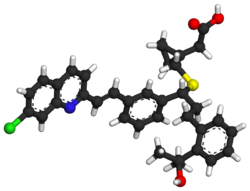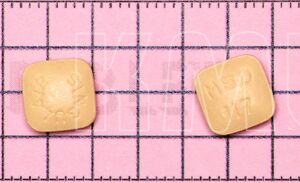Montelukast
 | |
 | |
| Names | |
|---|---|
| Trade names | Singulair, others |
| |
| Clinical data | |
| Drug class | Leukotriene receptor antagonist |
| Main uses | Maintenance treatment of asthma[1] |
| Side effects | Abdominal pain, cough, headache[1] |
| Pregnancy category | |
| Routes of use | By mouth |
| Defined daily dose | 10 mg[3] |
| External links | |
| AHFS/Drugs.com | Monograph |
| MedlinePlus | a600014 |
| Legal | |
| License data |
|
| Legal status | |
| Pharmacokinetics | |
| Bioavailability | 63–73% |
| Protein binding | 99% |
| Metabolism | Liver (CYP2C8-major, CYP3A4 and CYP2C9-minor)[4] |
| Elimination half-life | 2.7–5.5 hours |
| Excretion | Biliary |
| Chemical and physical data | |
| Formula | C35H36ClNO3S |
| Molar mass | 586.19 g·mol−1 |
| 3D model (JSmol) | |
| Melting point | 145 to 148 °C (293 to 298 °F) |
| |
| |
Montelukast, sold under the brand name Singulair among others, is a medication used in the maintenance treatment of asthma.[1] It is generally less preferred for this use than inhaled corticosteroids.[1] It is not useful for acute asthma attacks.[1] Other uses include allergic rhinitis and hives of long duration.[1] For allergic rhinitis it is a second line treatment.[5] It is taken by mouth.[1]
Common side effects include abdominal pain, cough, and headache.[1] Severe side effects may include allergic reactions, such as anaphylaxis and eosinophilia.[1] Use in pregnancy appears to be safe.[1] Montelukast is in the leukotriene receptor antagonist family of medications.[1] It works by blocking the action of leukotriene D4 in the lungs resulting in decreased inflammation and relaxation of smooth muscle.[1]
Montelukast was approved for medical use in the United States in 1998.[1] It is available as a generic medication.[6] In the United States, the wholesale cost per dose is less than 0.15 USD as of 2018.[7] In 2017, it was the 16th most commonly prescribed medication in the United States, with more than 31 million prescriptions.[8][9]
Medical uses
Montelukast is used for a number of conditions including asthma, exercise induced bronchospasm, allergic rhinitis, and urticaria.[10] It is mainly used as a complementary therapy in adults in addition to inhaled corticosteroids, if inhaled steroids alone do not bring the desired effect. It is also used to prevent allergic reactions and asthma flare-ups during the administration of intravenous immunoglobulin. It may also be used as an adjunct therapy in symptomatic treatment of mastocytosis.[11]
Montelukast is usually taken once a day with or without food.[12]
Dosage
The defined daily dose is 10 mg by mouth.[3]
Side effects
Common side effects include diarrhea, nausea, vomiting, mild rashes, asymptomatic elevations in liver enzymes, and fever. Uncommon side effects include fatigue and malaise, behavioral changes, paresthesias and seizures, muscle cramps, and nose bleeds. Rare (may affect up to 1 in 10,000 people taking montelukast) but serious side effects include behavioral changes (including suicidal thoughts), angioedema, erythema multiforme, and liver problems.[4]
In 2019 and 2020, concerns for neuropsychiatric reactions were added to the label in the United Kingdom and United States where the most frequently suspected were nightmares, depression, insomnia (may affect between 1 in 100 to 1 in 1,000 people taking montelukast); aggression, anxiety and abnormal behaviour or changes in behaviour (may affect between 1 in 1,000 to 1 in 10,000 people taking montelukast).[13][14]
FDA investigation
In June 2009, the U.S. Food and Drug Administration (FDA) concluded a review into the possibility of neuropsychiatric side effects with leukotriene modulator drugs.[15] Although clinical trials only revealed an increased risk of insomnia, post-marketing surveillance showed that the drugs are associated with a possible increase in suicidal behavior and other side effects such as agitation, aggression, anxiousness, dream abnormalities and hallucinations, depression, irritability, restlessness, and tremor.[15]
In September 2019, the Pediatric Advisory Committee and the Drug Safety and Risk Management Advisory Committee met to discuss a pediatric-focused safety review of neuropsychiatric events with montelukast.[16]
In March 2020, the FDA required a boxed warning for montelukast to strengthen an existing warning about the risk of neuropsychiatric events associated with the drug in the wake of an increase in case reporting of neuropsychiatric events around the time of the initial communications about the concern from FDA in 2008.[17][18][14] The boxed warning advises health care providers to avoid prescribing montelukast for people with mild symptoms, particularly those with allergic rhinitis because there are many other effective, less-concerned allergy medicines that are also indicated for the mild cases.[17]
In the FDA's self-conducted data analysis in comparison to their received case reports which were dependent on people's self-claims, the propensity of developing neuropsychiatric disorders after montelukast use does not outpace that of inhaled corticosteroids; and there were no statistically significant risks of new-onset neuropsychiatric disorders among males, females, patients 12 years and older, patients with a psychiatric history, or after the 2008 FDA communication and prescribing information changes that first publicized the concern.[18] In addition, FDA's self-conducted data analysis also summarized their own findings, saying "exposure to montelukast was significantly associated with a decreased risk of treated outpatient depressive disorder and the decreased risks were seen among patients with a history of a psychiatric disorder, in patients 12 to 17 years as well as 18 years and older, and in both females and males."[18] "Treated outpatient depressive disorder" refers to patients' actions of making an appointment with psychiatrists to contend with their depressions.[18]
Interactions
Montelukast has very few drug-drug interactions. This is due to the lack of off-target affinity towards other targets in the body where it might exert an effect.[medical citation needed] However, it is important to note that montelukast is an inhibitor of the drug metabolizing enzyme CYP2C8. Therefore, it is theoretically possible that the combination of montelukast with a CYP2C8 substrate (e.g. amodiaquine, an anti-malarial drug) could increase the plasma concentrations of the substrate.[19][20]
Pharmacology
Montelukast is in the leukotriene receptor antagonist family of medications.[1] It works by blocking the action of leukotriene D4 in the lungs resulting in decreased inflammation and relaxation of smooth muscle.[1]
Montelukast functions as a leukotriene receptor antagonist (cysteinyl leukotriene receptors) and consequently opposes the function of these inflammatory mediators; leukotrienes are produced by the immune system and serve to promote bronchoconstriction, inflammation, microvascular permeability, and mucus secretion in asthma and COPD.[21] Leukotriene receptor antagonists are sometimes colloquially referred to as leukasts.
Two genes of interest are ALOX5 and LTC4S, which catalyze two major steps in the biosynthetic pathway of leukotrienes.[citation needed]
Society and culture
Cost
In the United States, the wholesale cost per dose is less than 0.15 USD as of 2018.[7] In 2017, it was the 16th most commonly prescribed medication in the United States, with more than 31 million prescriptions.[8][9]
-
Montelukast costs (US)
-
Montelukast prescriptions (US)
Patents

Singulair was covered by U.S. Patent No. 5,565,473[22] which expired on August 3, 2012.[23] The same day, the FDA approved several generic versions of montelukast.[24]
The United States Patent and Trademark Office launched a reexamination of the patent covering Singulair on May 28, 2009. The decision was driven by the discovery of references that were not included in the original patent application process. The references were submitted through Article One Partners, an online research community focused on finding literature relating to existing patents. The references included a scientific article produced by a Merck employee on the active ingredient in Singulair. A previously filed patent had been submitted in the same technology area.[25] Seven months later the U.S. Patent and Trademark Office determined that the patent in question was valid based on the initial reexamination and new information provided, submitting their decision on December 17, 2009.[26]
Use with loratadine
Schering-Plough and Merck sought permission to market a combined tablet with loratadine and montelukast. However, the FDA has found no benefit from a combined pill for seasonal allergies over taking the two drugs in combination,[27] and on April 25, 2008, issued a not-approvable letter for the combination.[28]
Names
The Mont in montelukast stands for Montreal, the place where Merck (MSD) developed the drug.[29]
Montelukast is sold under a variety of brand names including Montenaaf (NAAFCO Pharma) Montelon-10 (Apex), Montene (Square), Montair-10, Montelo-10, Monteflo, and Tukast L in India, Reversair (ACI Bangladesh), Miralust, Montiva, Provair, Montril, Lumona, Lumenta, Arokast and Trilock in Bangladesh, Ventair in Nepal, Montika in Pakistan, Montelair in Brazil, Zykast in the Philippines though combined with levocetirizine, Notta in Turkey, Topraz in South Africa and AirOn in Venezuela.
References
- ↑ 1.00 1.01 1.02 1.03 1.04 1.05 1.06 1.07 1.08 1.09 1.10 1.11 1.12 1.13 1.14 "Montelukast Sodium Monograph for Professionals". Drugs.com. AHFS. Archived from the original on 7 June 2019. Retrieved 23 December 2018.
- ↑ 2.0 2.1 "Montelukast (Singulair) Use During Pregnancy". Drugs.com. 13 December 2019. Archived from the original on 7 August 2019. Retrieved 4 March 2020.
- ↑ 3.0 3.1 "WHOCC - ATC/DDD Index". www.whocc.no. Archived from the original on 19 September 2020. Retrieved 9 September 2020.
- ↑ 4.0 4.1 "Montelukast 10 mg film coated tablets - Summary of Product Characteristics (SmPC) - (eMC)". Archived from the original on 23 December 2018. Retrieved 23 December 2018.
- ↑ Grainger, J.; Drake-Lee, A. (2006). "Montelukast in allergic rhinitis: a systematic review and meta-analysis". Clinical Otolaryngology. Wiley. 31 (5): 360–367. doi:10.1111/j.1749-4486.2006.01276.x. ISSN 0307-7772. PMID 17014443.
regarded as second line therapy. When used, montelukast should be used in combination with an antihistamine.
- ↑ British national formulary : BNF 76 (76 ed.). Pharmaceutical Press. 2018. p. 269. ISBN 9780857113382.
- ↑ 7.0 7.1 "NADAC as of 2018-12-19". Centers for Medicare and Medicaid Services. Archived from the original on 19 December 2018. Retrieved 22 December 2018.
- ↑ 8.0 8.1 "The Top 300 of 2020". ClinCalc. Archived from the original on 12 February 2021. Retrieved 4 March 2020.
- ↑ 9.0 9.1 "Montelukast - Drug Usage Statistics". ClinCalc. 23 December 2019. Archived from the original on 11 April 2020. Retrieved 11 April 2020.
- ↑ "Montelukast Sodium". The American Society of Health-System Pharmacists. Archived from the original on 7 June 2019. Retrieved 3 April 2011.
- ↑ Cardet JC, Akin C, Lee MJ (October 2013). "Mastocytosis: Update on pharmacotherapy and future directions". Expert Opinion on Pharmacotherapy. 14 (15): 2033–2045. doi:10.1517/14656566.2013.824424. PMC 4362676. PMID 24044484.
- ↑ Montelukast article on Medline Plus https://www.nlm.nih.gov/medlineplus/druginfo/meds/a600014.html Archived 5 July 2016 at the Wayback Machine "Montelukast comes as a tablet, a chewable tablet, and granules to take by mouth. Montelukast is usually taken once a day with or without food."
- ↑ "Montelukast (Singulair): reminder of the risk of neuropsychiatric reactions". Archived from the original on 24 September 2019. Retrieved 19 September 2019.
- ↑ 14.0 14.1 "Singulair (montelukast) and All Generics: Strengthened Boxed Warning". U.S. Food and Drug Administration (FDA). 4 March 2020. Archived from the original on 4 March 2020. Retrieved 4 March 2020.
 This article incorporates text from this source, which is in the public domain.
This article incorporates text from this source, which is in the public domain.
- ↑ 15.0 15.1 "Updated Information on Leukotriene Inhibitors: Montelukast (marketed as Singulair), Zafirlukast (marketed as Accolate), and Zileuton (marketed as Zyflo and Zyflo CR)". U.S. Food and Drug Administration (FDA). 12 June 2009. Archived from the original on 14 November 2017. Retrieved 1 March 2017.
- ↑ "FDA Joint Pediatric Advisory Committee and Drug Safety and Risk Management Advisory Committee; Notice of Meeting". Archived from the original on 24 September 2019. Retrieved 24 September 2019.
- ↑ 17.0 17.1 "FDA Requires Stronger Warning About Risk of Neuropsychiatric Events Associated with Asthma and Allergy Medication Singulair and Generic Montelukast". U.S. Food and Drug Administration (FDA) (Press release). 4 March 2020. Archived from the original on 4 March 2020. Retrieved 4 March 2020.
 This article incorporates text from this source, which is in the public domain.
This article incorporates text from this source, which is in the public domain.
- ↑ 18.0 18.1 18.2 18.3 "FDA requires Boxed Warning about serious mental health side effects for asthma and allergy drug montelukast (Singulair); advises restricting use for allergic rhinitis". U.S.Food and Drug Administration (FDA). 4 March 2020. Archived from the original on 4 March 2020. Retrieved 4 March 2020.
 This article incorporates text from this source, which is in the public domain.
This article incorporates text from this source, which is in the public domain.
- ↑ Artesunate Amodiaquine Winthrop (artesunate, amodiaquine) [summary of product characteristics]. Gentilly, France: Sanofi-aventis; August 2010. http://www.wipo.int/export/sites/www/research/en/data/sanofi/marketed_products/Artesunate_and_Amodiquine.pdf Archived 24 October 2016 at the Wayback Machine
- ↑ German P, Greenhouse B, Coates C, et al. (March 2007). "Hepatotoxicity due to a drug interaction between amodiaquine plus artesunate and efavirenz". Clin. Infect. Dis. 44 (6): 889–91. doi:10.1086/511882. PMID 17304470.
- ↑ Scott JP, Peters-Golden M (September 2013). "Antileukotriene agents for the treatment of lung disease". Am. J. Respir. Crit. Care Med. 188 (5): 538–544. doi:10.1164/rccm.201301-0023PP. PMID 23822826.
- ↑ "5,565,473". Archived from the original on 10 June 2021. Retrieved 14 March 2022.
- ↑ "Singular patent details". Archived from the original on 15 August 2011. Retrieved 5 December 2009.
- ↑ "FDA approves first generic versions of Singulair to treat asthma, allergies". 3 August 2012. Archived from the original on 6 August 2012. Retrieved 15 August 2012.
- ↑ "U.S. Reexamines Merck's Singulair Patent". Thompson Reuters. 28 May 2009. Archived from the original on 24 September 2015. Retrieved 1 July 2017.
- ↑ "Merck Says U.S. Agency Upholds Singulair Patent". Thompson Reuters. 17 December 2009. Archived from the original on 24 September 2015. Retrieved 1 July 2017.
- ↑ Rubenstein, Sarah (28 April 2008). "FDA Sneezes at Claritin-Singulair Combo Pill". The Wall Street Journal. Archived from the original on 25 March 2017. Retrieved 4 August 2017.
- ↑ "Schering-Plough/MERCK Pharmaceuticals Receives Not-Approvable Letter from FDA for Loratadine/Montelukast". Schering-Plough (Press release). 25 April 2008. Archived from the original on 24 September 2008. Retrieved 17 March 2020.
- ↑ Li, Jie Jack (2006). "8". Laughing Gas, Viagra, and Lipitor: The Human Stories Behind the Drugs We Use. Oxford University Press. p. 234. ISBN 978-0195300994. Archived from the original on 1 December 2017. Retrieved 26 November 2017.
External links
| External sites: | |
|---|---|
| Identifiers: |
|
- Pages using duplicate arguments in template calls
- Webarchive template wayback links
- Wikipedia articles incorporating the PD-notice template
- Use dmy dates from March 2020
- Articles with invalid date parameter in template
- Chemical articles with unknown parameter in Infobox drug
- Chemical articles without CAS registry number
- Articles without EBI source
- Chemical pages without ChemSpiderID
- Chemical pages without DrugBank identifier
- Articles without KEGG source
- Articles without UNII source
- Drugs missing an ATC code
- Drug has EMA link
- Drugboxes which contain changes to watched fields
- All articles with unsourced statements
- Articles with unsourced statements from March 2020
- Articles with hatnote templates targeting a nonexistent page
- Articles with unsourced statements from November 2017
- Alkene derivatives
- Chloroarenes
- Cyclopropanes
- Leukotriene antagonists
- Merck & Co. brands
- Quinolines
- Thioethers
- RTT

